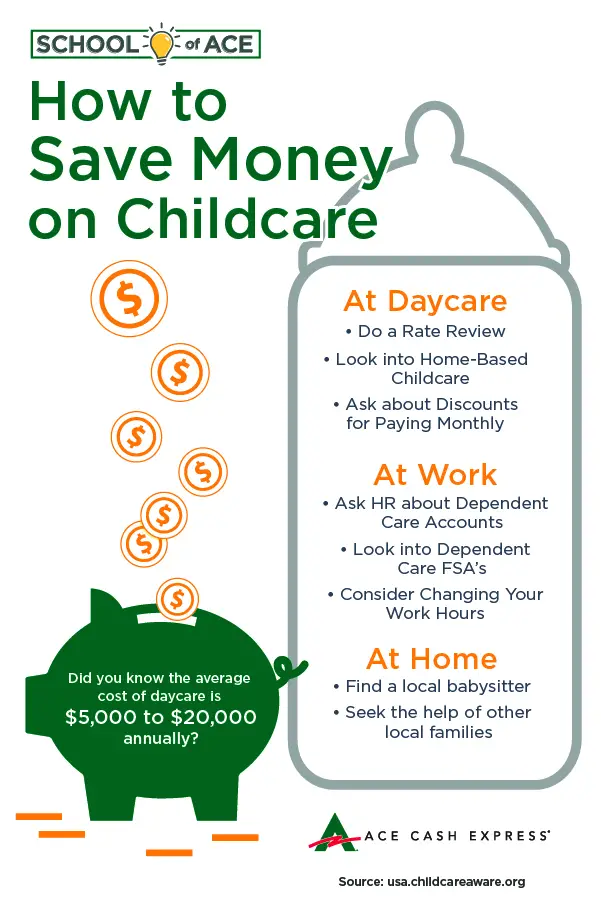In this article, I’ll be discussing 10 ways to save money on childcare. We all know how expensive childcare can be, so I’ll be sharing some tips and tricks to help you navigate this cost and potentially save some money. From finding affordable options to maximizing government assistance programs, you’ll learn various strategies to make childcare more affordable without compromising the quality of care for your child. So, if you’re looking for ways to cut back on childcare expenses, keep reading to discover some helpful ideas.
10 Ways to Save Money on Childcare
As a parent, finding affordable childcare options is a top priority. While the cost of childcare can often be overwhelming, there are various strategies you can implement to minimize expenses and save money. In this article, I will share 10 effective ways to save money on childcare while still ensuring the well-being and safety of your child.
Researching Local Daycare Centers
When looking for affordable childcare options, local daycare centers are a popular choice for many parents. It is essential to thoroughly research daycare centers in your area to find the most cost-effective option. Compare prices, services offered, and the quality of care provided. Consider visiting the centers in person to assess their facilities and meet the staff. By doing your due diligence, you can find a daycare center that fits both your budget and your child’s needs.
Considering In-Home Daycare Services
Another cost-saving option to explore is in-home daycare services. In-home daycare providers offer a more intimate setting for your child, often at a lower cost than traditional daycare centers. By choosing this option, you can potentially save money while still ensuring your child receives the care and attention they need. Make sure to thoroughly vet potential in-home daycare providers and check their references to ensure the safety and reliability of their services.
Exploring Co-Op Daycare Programs
Co-op daycare programs are an excellent way to save money on childcare while also actively participating in your child’s early development. In co-op programs, parents take turns providing childcare, thereby eliminating the need for professional daycare services. By joining a co-op program, you can significantly reduce childcare expenses while also building a supportive community with fellow parents.
Utilizing Government Assistance Programs
Government assistance programs can provide valuable financial support for families seeking affordable childcare options. It is crucial to understand the eligibility criteria for these programs and determine if you qualify. Programs such as Childcare Subsidies can help alleviate the financial burden by covering a portion of your childcare expenses. Take the time to research and apply for these programs to see if they can provide you with the financial assistance you need.
Understanding Eligibility Criteria
Before applying for government assistance programs, it is crucial to understand the eligibility criteria. Each program has specific requirements, such as income limits and additional qualifying factors. By familiarizing yourself with these criteria, you can determine if you qualify for financial support and proceed with the application process confidently.
Applying for Childcare Subsidies
Once you have determined your eligibility for government assistance programs, such as Childcare Subsidies, make sure to gather all the necessary documentation and complete the application accurately and thoroughly. Applying for childcare subsidies can significantly reduce your out-of-pocket expenses, allowing you to allocate your resources to other essential areas of your family’s budget.
Engaging in Babysitting Exchanges
Babysitting exchanges offer a cost-effective solution for parents who are looking for temporary childcare arrangements. By organizing babysitting co-ops, parents can take turns providing childcare for each other’s children, eliminating the need for paid babysitters. This approach not only saves money but also builds connections within your community and fosters meaningful relationships with other parents.
Organizing Babysitting Co-Ops
To establish a successful babysitting co-op, organize a group of trustworthy parents within your community who are interested in participating. Set up a schedule that works for everyone involved and establish clear expectations and guidelines. By collaborating and sharing childcare responsibilities, you can ensure that each parent gets the support they need while minimizing the financial impact.
Joining Online Babysitting Networks
In addition to organizing personal babysitting co-ops, you can also explore online babysitting networks to find cost-effective childcare options. Websites and apps that connect parents seeking babysitting services with qualified caregivers provide a platform for affordable childcare arrangements. By joining these online networks, you can access a wide pool of trusted caregivers at a fraction of the cost of traditional babysitting services.
Seeking Financial Support from Family and Friends
When facing financial constraints in childcare, it is essential to reach out to your extended network for support. Communicate your need for assistance to family and friends who may be willing and able to help. Establish clear expectations and boundaries to ensure everyone is on the same page. While it may not be a long-term solution, seeking support from loved ones can provide temporary relief and allow you to allocate your resources strategically.
Negotiating Flexible Work Arrangements
Exploring flexible work arrangements with your employer can provide valuable opportunities to save on childcare expenses. Discuss the possibility of remote work options or part-time schedules that allow you to be more present for your child while still fulfilling your work commitments. By finding a balance that works for both you and your employer, you can reduce the need for full-time childcare services and save money in the process.
Exploring Remote Work Options
Remote work has become increasingly common, and many employers offer flexible work arrangements. Explore the possibility of working remotely, whether part-time or full-time, to save on childcare expenses. Remote work allows you to be more available for your child while still earning an income, providing a cost-effective solution for many parents.
Discussing Part-Time Schedules
If remote work is not an option, discuss the possibility of transitioning to a part-time schedule with your employer. This arrangement can significantly reduce your childcare expenses while still allowing you to maintain a connection to the workforce and your career. By finding a work schedule that aligns with your childcare needs, you can achieve a balance that benefits both you and your family financially.
Taking Advantage of Employer Benefits
Many employers offer benefits specifically designed to support working parents. By understanding and utilizing these benefits, you can save money on childcare expenses. Employer-sponsored childcare programs, for example, provide on-site daycare or partnerships with local childcare centers. By taking advantage of these programs, you can access quality childcare options at a reduced cost.
Understanding Employer-Sponsored Childcare Programs
If your employer offers an on-site or sponsored childcare program, familiarize yourself with the details and requirements. Determine if your child is eligible to participate and evaluate the overall cost savings compared to alternative childcare options. Employer-sponsored childcare programs can be a valuable resource for working parents striving to minimize childcare expenses.
Maximizing Dependent Care Flexible Spending Accounts
Another aspect of employer benefits to consider is Dependent Care Flexible Spending Accounts (FSAs). FSAs allow you to set aside pre-tax dollars to cover eligible childcare expenses. By allocating a portion of your income to a Dependent Care FSA, you can significantly reduce your taxable income while providing for your child’s care needs. Consult with your employer’s benefits department to determine the maximum contribution allowed and take full advantage of this cost-saving opportunity.
Creating a Budget for Childcare Expenses
Implementing a budget specifically for childcare expenses is essential for effective cost management. Analyze your income and expenses to determine how much you can allocate towards childcare. Identify areas in your budget where you can make adjustments to maximize savings. By creating a comprehensive childcare budget, you can ensure that your financial resources are allocated efficiently and effectively.
Analyzing Income and Expenses
To create a realistic childcare budget, it is crucial to analyze your income and expenses thoroughly. Consider all aspects of your financial situation, including monthly income, recurring expenses, and any additional sources of financial support. By understanding your financial picture, you can establish a budget that takes into account your specific circumstances.
Identifying Areas for Cost Reduction
Once you have established a childcare budget, identify areas where you can reduce costs without compromising the well-being and safety of your child. Look for opportunities to cut expenses, such as minimizing discretionary spending or reallocating funds from non-essential areas. By evaluating your budget, you can identify areas where small changes can have a significant impact on your overall financial stability.
Implementing Cost-Saving Strategies at Home
Saving money on childcare expenses can extend beyond the childcare facility itself. By implementing cost-saving strategies at home, you can further reduce the financial burden of raising a child. Consider utilizing cloth diapers instead of disposable ones, as they are reusable and more cost-effective in the long run. Additionally, preparing homemade baby food can be significantly cheaper than purchasing pre-packaged options.
Utilizing Cloth Diapers
Using cloth diapers instead of disposable ones can lead to substantial cost savings over time. While the initial investment may seem higher, the long-term savings are well worth it. Cloth diapers are reusable, reducing the need for continuous purchases and contributing to a more sustainable approach to childcare.
Preparing Homemade Baby Food
Another cost-saving strategy parents can implement is preparing homemade baby food. Purchasing pre-packaged baby food can add up quickly, especially when considering the long duration of a child’s need for pureed or mashed foods. By making baby food at home using fresh ingredients, parents can substantially reduce expenses and provide their child with healthier alternatives.
Maximizing Tax Credits and Deductions
When it comes to saving money on childcare, it is essential to maximize available tax credits and deductions. Two valuable options to consider are the Child and Dependent Care Credit and the Dependent Care FSA. These tax benefits can significantly reduce your tax liability and provide an opportunity to recoup some of the funds spent on childcare expenses.
Claiming the Child and Dependent Care Credit
The Child and Dependent Care Credit is a valuable tax credit that provides financial relief for eligible childcare expenses. By claiming this credit, you can reduce your taxable income and potentially receive a refund. Ensure that you meet the eligibility requirements and accurately report your childcare expenses when filing your taxes to take advantage of this cost-saving opportunity.
Utilizing the Dependent Care FSA
In addition to tax credits, maximizing your use of a Dependent Care FSA can provide additional savings. As mentioned earlier, a Dependent Care FSA allows you to allocate pre-tax dollars to cover eligible childcare expenses. By actively contributing to this account, you can significantly reduce your taxable income and save money on childcare costs.
Exploring Alternative Childcare Options
Alongside traditional daycare centers and in-home services, there are alternative childcare options worth exploring. Family daycare providers, such as grandparents or other relatives, can offer cost-effective solutions while providing a familiar and nurturing environment for your child. Additionally, hiring an au pair can provide affordable live-in childcare support.
Utilizing Family Daycare Providers
If you have family members or close friends who are willing and available to provide childcare, consider utilizing their services. Family daycare providers can offer a more cost-effective solution while ensuring your child receives personalized care and attention. However, it is crucial to establish clear boundaries and expectations to maintain healthy relationships.
Hiring Au Pairs
For a more unique and immersive childcare experience, hiring an au pair can be a cost-effective option. Au pairs are young individuals from other countries who live with your family and provide childcare in exchange for room, board, and a stipend. By welcoming an au pair into your home, you can save money on traditional childcare expenses while also offering a cultural exchange experience for your child.
Investigating Community Resources
Communities often offer various resources and programs that can be beneficial for families seeking affordable childcare options. Preschool cooperative programs, for example, allow parents to actively participate in their child’s early education while saving on costs. Participating in public recreation programs can also provide enriching experiences for your child at a lower cost.
Exploring Preschool Cooperative Programs
Preschool cooperative programs are an excellent option to consider for childcare and early education. In these programs, parents actively participate in the operation of the preschool, allowing for reduced costs. By sharing responsibilities with other parents, you can save money on childcare expenses while actively engaging in your child’s development.
Participating in Public Recreation Programs
Public recreation programs often offer affordable childcare options during school breaks or summer months. These programs provide structured activities and supervision for children at a lower cost compared to traditional daycare services. Investigate local community centers and parks to explore the public recreation programs available in your area.
Joining Parenting Support Groups
Parenting support groups offer a valuable network of resources and support for parents seeking affordable childcare options. By joining these groups, you can connect with other parents facing similar financial challenges and share advice on cost-saving strategies. Parenting support groups may also arrange for shared babysitting responsibilities, further reducing childcare expenses.
Sharing Babysitting Responsibilities with Other Parents
Within parenting support groups or your local community, consider organizing shared babysitting responsibilities with other parents. By pooling resources and taking turns providing childcare, you can significantly reduce expenses while ensuring your child is well-cared for. Establish clear guidelines and expectations to create a successful and mutually beneficial arrangement.
Pooling Resources for Childcare Expenses
Another option within parenting support groups is pooling financial resources for childcare expenses. By collectively contributing to a childcare fund, parents can access quality childcare options at a lower cost. This approach allows for flexibility and the ability to seek out reputable caregivers who may otherwise be financially out of reach.
Planning in Advance for Childcare Needs
Lastly, planning in advance for childcare needs is crucial for effective cost management. By anticipating future expenses and establishing emergency funds, you can alleviate the financial stress associated with unexpected changes in your childcare arrangements. Take the time to assess your family’s needs and set aside funds specifically designated for childcare expenses.
Anticipating Future Expenses
Childcare expenses can fluctuate as your child grows and their needs change. Anticipate future expenses by considering potential transitions, such as moving from daycare to preschool or entering school-aged programs. By planning ahead, you can budget for these changes and minimize financial surprises along the way.
Establishing Emergency Funds
Unforeseen circumstances can significantly impact your childcare arrangements and budget. Establishing an emergency fund specifically designated for childcare expenses can provide much-needed security and peace of mind. Aim to save an amount that covers at least three to six months’ worth of childcare costs to ensure you can navigate unexpected challenges without financial strain.

Conclusion
Saving money on childcare is an important aspect of managing a family’s finances. By implementing the strategies outlined in this article, you can make informed decisions to minimize childcare expenses while still ensuring your child receives quality care. Remember to thoroughly research local daycare centers, explore government assistance programs, engage in babysitting exchanges, seek support from family and friends, and take advantage of employer benefits. Additionally, create a budget, implement cost-saving strategies at home, and maximize available tax credits and deductions. By exploring alternative childcare options, investigating community resources, joining parenting support groups, and planning in advance, you can navigate the financial challenges associated with childcare and create a more financially secure future for your family.


